The agama lizard is a docile lizard and part of the Old World Lizards group. Native to Sub-Saharan Africa, the agama lizard lives in arid and semi-desert environments. Most adult lizards will grow up to 12 inches long and display a black/brown coloration with a white underbelly.
Agama lizards are easy to care for and best suited to beginner and intermediate reptile hobbyists. With the right care, enclosure setup, and diet, these lizards can live for up to 25 years.
Agama Lizard Overview
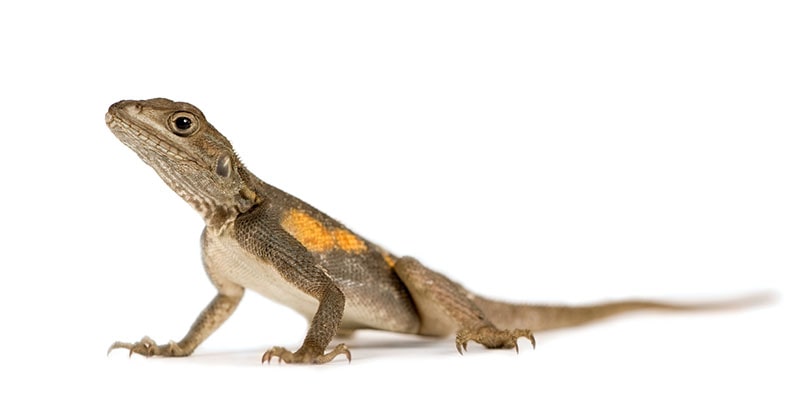
| Common name | Agama, red-headed rock agama, or rainbow agama |
| Scientific name | Agama |
| Natural habitat | Arid and semi-desert environments in Sub-Saharan Africa, |
| Adult size | 5– 2 inches |
| Average lifespan | 20–25 years |
| Diet | Ants, termites, beetles, grasshoppers, small mammals, other reptiles, plants |
| Housing | A fish tank with plenty of ground space, natural branches and rocks, heat lamp, airstone, and a soil or sand substrate |
| Experience level | Beginner and intermediate |
Agama Lizard Origin
The agama lizard (Agama) is native to Sub-Saharan Africa. Its natural habitat is dry and desert-like, but the agama lizard has adapted to living in urbanized areas too and can be found in thatch or similar sheltered areas in villages.
The species is distributed around India, Madagascar, and the dry Mediterranean regions of Europe. It is also common in Southern Florida and the surrounding areas as agama lizards were introduced to the states via the reptile trade.
The agama lizard is common in the wild and urban areas, though they stay hidden in brushes and vegetation whenever possible.
Appearance and Behavior
Agama lizards are often grey or brown, but they can display various color combinations. They are sometimes called rainbow lizards because dominant males change their color to show off and attract females. Their bodies often turn blue, and their heads turn red or yellow when males want to assert their dominance.
The subordinate males and females have olive-green heads. Male and female agama lizards have a white underbelly and a light-colored stripe down the middle of their tail. They also have dark patches of skin on either side of the stripe. These lizards have external ear openings and eyelids, as well as incisors and cheek teeth.
Agama lizards are mild-mannered and docile. Males will defend their territory and bob their heads if they feel threatened, and they will also change color in an attempt to scare away potential predators. Males use their tails for protection and charge with their mouths open.
Males work to gain attention from females during mating. Males bob their heads until they receive permission from females to mate. Males can also change color during mating.
Agama lizards are territorial and live in social groups in the wild. These groups usually consist of one dominant male, several females, and subordinate males. Subordinate males either have to usurp the head cock or move on to establish their own territory to mate.
Agama lizards are active most of the day. These lizards bask in the sun during the hottest hours of the day, usually between 10 am and 12 pm.
The dominant male will claim the highest resting spot in the enclosure, with females and other males lounging below him. The agama’s color will darken later in the day, which makes morning basking more effective.
Size and Lifespan
The agama lizard’s average size is between 5 to 12 inches long. Unlike other lizards, they don’t have prominent dewlaps or crests. Much of their length comes from their tail, which is long compared to its body length. The male is, on average, 3 to 5 inches longer than the female agama lizard.
Agama lizards live between 20 and 25 years. However, they can live longer in captivity. This is because captive lizards aren’t exposed to predators and other dangers, which increases their life expectancy.
Temperament
Agama lizards are mostly docile creatures, but they will fight with other reptiles if they feel threatened or scared. Male agamas raise and lower their heads to intimidate predators, which is something that you might notice your captive lizard do.
Agama lizards should be housed together in captivity. Experts recommend keeping at least three in a group, and groups should consist of one male and two females.
These lizards can be held by humans and will become tamer the more they are handled. Agama lizards aren’t prone to biting or harming handlers unless they feel threatened. If you do get bitten, clean the area with warm water and antibacterial soap.
Housing Agama Lizards
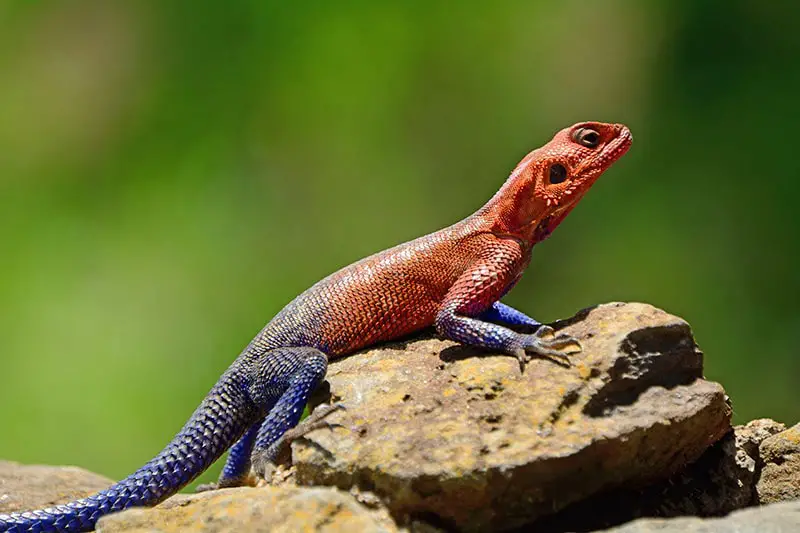
The agama lizard prefers hot, dry, vegetated climates, so you should recreate their natural habitat in captivity.
This species of lizard is active, so keep that in mind when choosing a tank. Either an aquarium or vivarium is a good choice of housing for an agama lizard.
Cover the bottom of the tank with a sand or soil substrate. Use rocks to create spacious hiding spaces, and add branches and artificial plants so your lizards can climb and play. Include a water bowl and a heat lamp to help the lizards stay warm, which will also allow your lizards to bask in the heat.
Enclosure size
The number of lizards you have dictates how large the enclosure should be. An aquarium is an excellent way to keep your agama lizards contained if they are in a small group. The enclosure should be at least 48x24x24 inches for a group of three lizards.
Lighting
Lizards are cold-blooded, so you will need to install a heat lamp. A basking lamp is a great choice, and you should choose a lamp with a red light that can be on all day. Agama lizards also need exposure to UVB rays. A 10% desert lamp is a good choice.
Temperature and Humidity
The enclosure temperature should stay constant, so make sure the enclosure is kept between 80 to 85 °F during the day and 74 to 78 °F at night. The basking area should stay at 95 °F. Using a heating pad will stabilize the temperature throughout the enclosure.
Humidity levels are important for agama lizards and should stay between 40°F and 60°F. Use a hygrometer to monitor humidity throughout the day.
Agama lizards shed their skin, so moisture is vital for their health. Full shedding can take up to a week or two, and proper temperature and humidity will ensure that your lizards will shed at the right time.
Substrate and Decoration
Cover the bottom of the enclosure with soil, sand, or a combined substrate. Decorate the tank with artificial plants, branches, and rocks to make shelters, and provide agama lizards with bedding that has low moisture retention. They need a warm, dry place to rest and sleep.
The agama lizard needs space to move around in, so avoid overcrowding the tank. Separate decorations in the tank to give the lizard room to roam.
Cleaning
Maintaining a clean enclosure is vital. You should change the water in the lizard’s bowl, spot clean the enclosure daily, dispose of the substrate, and deep clean the enclosure every four months.
Remove the contents of the enclosure once every year and sanitize accessories and decorations. You should use soap and water and avoid harsh chemical cleaning products.
Lizards can remain in the enclosure during spot cleaning sessions. Relocate lizards to a temporary enclosure while deep cleaning. Ensure the temporary enclosure is deep and spacious, and make sure the enclosure is warm and has a water bowl for the lizards to drink from.
Agama Lizard Care
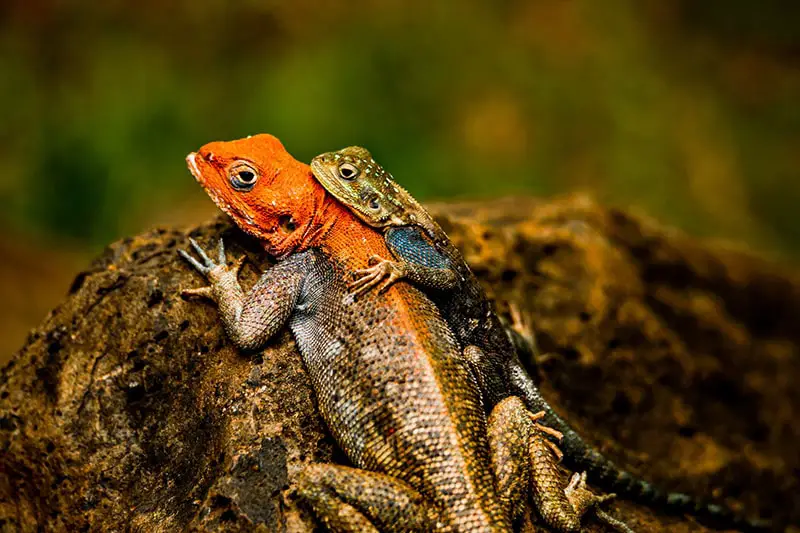
The agama lizard is easy to care for and ideal for beginner and intermediate reptile enthusiasts. The lizard needs an appropriate living environment, companions to share the tank with (males should not be housed together), and gentle handling. With proper care, your agama lizard will thrive.
Food and Water
Feed your adult agama lizard 15 to 20 crickets per day or 10 super worms two to three times each week. Make sure the insects are bigger than the lizard’s head to prevent choking.
Agama lizards are insectivores, which means they eat bugs and insects. Thermites, beetles, grasshoppers, and ants are part of agama lizards’ diet in the wild. Agama lizards also occasionally eat small mammals, other reptiles, and local vegetation, so captive agama lizards should eat super worms, mealworms, or crickets.
Your agama lizard should have access to clean, freshwater, so you should change the water every day. The agama lizard doesn’t drink still water and should drink water via an airstone or a water pump.
Handling
Agama lizards are safe to handle. Handlers should stay calm so that the lizards don’t feel stressed or threatened. Agama lizards take a long time to get used to handling and are easy to overhandle, so look out for changes in their behavior during handling.
Agama lizards will close their eyes when they feel stressed or threatened, so you should put them back in their enclosure when this happens.
Common Health Issues
The metabolic bone disorder is a common agama lizard health issue. Inadequate lighting and nutrient deficiencies will cause this health issue.
An agama lizard suffering from metabolic bone disorders can take calcium supplements as part of its treatment. Calcium supplements also aid the breeding process. Mites, worms, and other parasites are also a concern.
Agama lizards can also suffer from respiratory issues and bacterial infections, which is usually caused by dirty water and an unsanitary enclosure. Here are some signs to look out for:
- Weight loss
- Lethargy
- Appetite loss
- Changes in behavior
Sick lizards should follow a special diet or take nutritional supplements. Light therapy and antibiotics are also treatment options for certain conditions.
Breeding
Agama lizards breed all year round in captivity. However, reproduction occurs during the wet season in the wild. Females reach sexual maturity at 14 months old, and males reach sexual maturity at two years old.
Females will dig a hole in sandy soil to lay their eggs, usually located in a sunny location. Females will then cover the hole in grass and vegetation.
The gender of the hatchlings is determined by external factors such as incubation temperature. Eggs usually hatch within eight to 10 weeks.
- Begin the breeding process in March through to May.
- Keep two or three females with one male for breeding success.
- Ensure the enclosure has a dedicated space for the lizard eggs. Put the eggs in a lay box or plastic container filled with soft dirt of sphagnum moss.
- A female agama lizard will lay up to 20 eggs each time.
- Remove the eggs from the tank and place them in n incubator with an internal temperature of 85 °F (29.5 °C).
- Eggs will take up to 3 months to hatch.
- Baby agama lizards are just a few inches long and should be kept in a10–20 gallon enclosure filled with newspaper.
- Feed juvenile hatchlings crickets.
- Separate males and females as soon as possible.
Choosing and Buying an Agama Lizard
Purchase your lizard from a reputable breeder, pet store, or online. An agama lizard should cost $25 per lizard and is usually readily available for purchase in pet stores.
You should observe agama lizards before purchase. Healthy lizards have firm, smooth skin and should be active and lively, which is very easy to spot. Overall, this is a great pet and one that reptile-lovers will enjoy caring for.

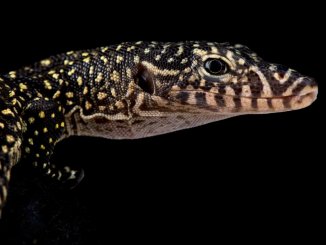
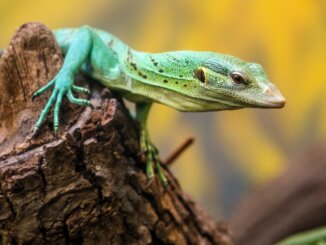
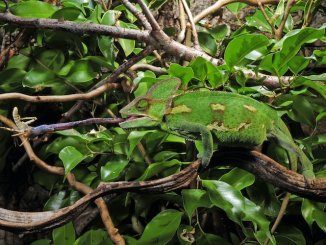

We just brought home a new Painted Agama 3 days ago. It’s a 2 year old male that was hatched and raised by a local family owned pet store. He had been housed with a female for quite some time and now that he is home with us and alone in his tank he seems very depressed. My daughter takes him out for about an hour a day, but when he is in his tank he spends probably a good 89-90% of his time hiding in his little cave hidey-hole. Any recommendations on what we can do to ease this transition for him or is it just going to take time? Thanks!!
Change-related stress is not uncommon in these cases. His world was completely changed after two long years, so it might take longer than 3 days to recover. Try avoid unnecessary handling, make sure the tank setup is ideal, provide different food sources, without drastic changes from his previous diet, and monitor whether he eats, don’t move in a way that might make him feel threatened.
With the correct care he will start to feel at home before you know it.